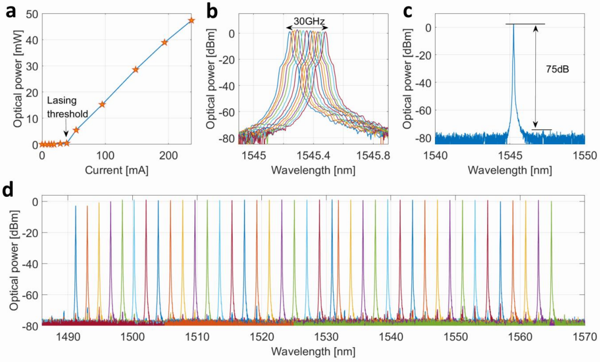The continuous variable quantum key distribution system (CV-QKD) based on Gaussian modulated coherent state protocol (GMCS protocol, also known as GG02 protocol) has many characteristics such as complete theoretical security proof, high secure key rate, compatibility with existing optical communication architecture, etc. It is one of the promising routes to build a high-performance quantum key distribution network in the future.
The emerging quantum photonics technology makes it possible to realize a highly stable, portable, scalable, miniaturized and low-cost on-chip continuous variable quantum key distribution system and quantum communication network terminal that can be flexibly deployed on a large scale. Although the CV-QKD system based on the off chip light source and the transmitted local oscillator (TLO) scheme has been preliminarily verified on the integrated chip platform, the integration of high-performance on-chip light sources suitable for the CV-QKD system has always been a challenging problem since the GG02 protocol was proposed.
The continuous variable quantum key distribution system based on the locally local oscillator (LLO) scheme can ensure that the quantum signal reaches the Quantum noise limit detection under the condition of long-distance transmission, and significantly eliminate the signal crosstalk through more robust local oscillator light, finally realizing a high-performance CV-QKD system that can support long-distance secure key distribution. It is an effective way to overcome the long-distance transmission limitations and practical security issues caused by local oscillator crosstalk signal light in TLO schemes. However, the integration of the LLO-CVQKD system imposes stricter requirements on the light source: (1) Precise wavelength tunability to meet the alignment of the central wavelengths of two independent lasers; (2) Sufficient optical output power to ensure Quantum noise limit detection; (3) Narrow linewidth and low noise to ensure non trusted noise suppression and secure key generation. Therefore, owning two efficient on-chip light sources with narrow line width, low noise, well tunability, and sufficient power remains a challenge, which is crucial for achieving high-performance CV-QKD systems and further promoting the deployment of integrated quantum communication networks.
To solve the above problems and achieve the integration of quantum light sources in the CV-QKD system, the research group led by Prof. Gui-hua Zeng from Shanghai Jiao Tong University cooperating with Prof. Lin-jie Zhou from Shanghai Jiao Tong University, proposed a compact and high-performance III-V/Si3N4 external cavity laser (ECL) with the characteristics of high output, narrow linewidth, wide wavelength tunability and high SMSR, which can overcome the above problems from a mechanism perspective. Finally, a complete LLO CV-QKD experimental system with a secure transmission distance exceeding 100 kilometers was implemented.
The relevant research results were published in Photonics Research, Volume. 11, Issue 4, 2023 (Lang Li, Tao Wang, Xinhang Li, Peng Huang, Yuyao Guo, Liangjun Lu, Linjie Zhou, Guihua Zeng. Continuous-variable quantum key distribution with on-chip light sources[J]. Photonics Research, 2023, 11(4): 504).
This work proposes and realizes two high-performance III-V silicon nitride external cavity chip tunable quantum light sources for CV-QKD, which have the characteristics of the highest output power (up to 47.3 mW), wide tuning range (up to 73 nm), narrow linewidth (as low as 1.6 kHz), and high side mode suppression ratio(up to 75 dB) among the existing quantum integrated light sources for QKD. It can simultaneously meet the strict requirements of CV-QKD chip system for quantum light source in three aspects: reaching the Quantum noise limit detection, central wavelength alignment of non homologous lasers, and untrusted excess noise suppression.

Fig. 1 (a). Schematic of the optical layer of the LLO-CVQKD system with on-chip III-V/Si3N4 external cavity laser. The integrated system contains two parties, Alice and Bob, as the transmitter and receiver. Alice's side consists of an isolator (Iso), two attenuators (ATT), an amplitude modulator (AM), a beamsplitter (BS), an IQ-modulator (IQ MOD), and a DC supply. Bob's side consists of two polarization controllers (PC) and an integrated coherent receiver (ICR). The photon detectors (PDs) are used for optical power monitoring. The inset shows the schematic structure of external cavity lasers (ECLs). (b). Photograph of the packaged ECLs. The RSOA is butt-coupled to an extension chip. The laser is supplied with electric current via wires. The on-chip light is measured and used in the QKD system using an optical fiber. (c). Microscope photo of the ECL. The footprint of the external chip is 2.4×1.27 mm2.

Fig. 2 (a). Optical spectrum of two lasers before (blue) and after (orange) adjustment. (b). Histogram of the measured beat frequency. (When measuring the change of the beat frequency, we use a data volume of 5 Mbits per frame and a sampling frequency of 10 Gbps to measure the frequency offset of the beat frequency. After analyzing the 800 frames of data, we found that the beat frequency of more than 70% of the frames is below 40 MHz, which sufficiently satisfies the demand of the system.) c. Frequency noise spectrum of the signal laser.
In addition, the team solved the practical security issues faced by the existing integrated CV-QKD system and the photon crosstalk of the local oscillator light in the TLO scheme by utilizing LLO solutions. Based on this laser, the team has achieved the first high-performance LLO CV-QKD system based on integrated on-chip light sources, with a secure key rate of 0.75 Mbps under 50 kilometers on standard commercial optical fibers and a secure transmission distance of over 100 kilometers on standard commercial optical fibers. This result marks a breakthrough in building a fully integrated CV-QKD system and paves the way for establishing a reliable and efficient ground quantum communication network.







